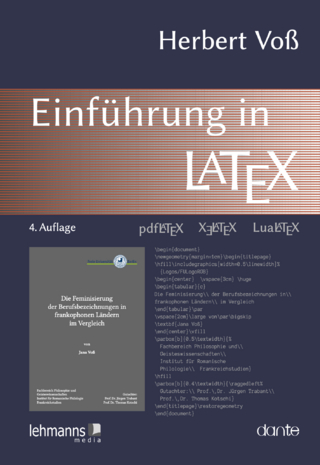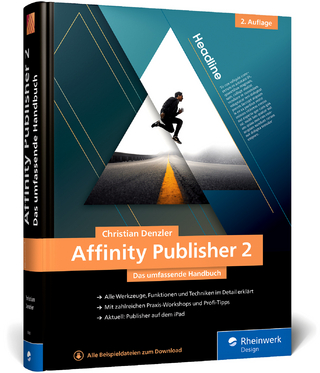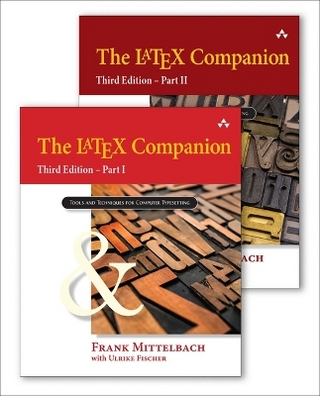
Illustrator 8 for Windows and Macintosh
Addison Wesley (Verlag)
978-0-201-35388-4 (ISBN)
- Titel ist leider vergriffen;
keine Neuauflage - Artikel merken
Adobe Illustrator is the industry standard indesktop illustration programs, but it can be intimidating to newcomers. It's a complex, powerful tool. Illustrator 8 for Windows and Macintosh: Visual QuickStart Guide is the ideal way for anyone to learn the newest version of the program. This step-by-step guide gives readers what they need to get right to work, without having to wander through menus or read a lot of text.
The book is an instruction guide to the newest version of the top-selling Illustrator program, written by two experienced computer instructors. Like the authors' previous Visual QuickStarts covering the best-selling QuarkXPress and Photoshop, the IIlustrator Visual QuickStart Guide's unique easy-to-use format is specifically tailored for the beginning to intermediate user: step-by-step instructions, hundreds of illustrations with detailed captions, and special tips to help users avoid potential problems. Elegant, original artwork created in Adobe Illustrator by the authors and their colleagues will both inspire and illuminate.
1. Illustrator Interface.
Using the Toolbox. The Illustrator screen: Macintosh. The Illustrator screen: Windows. Mini-glossary. Menus. Dialog boxes. Using the palettes. Color palette. Stroke palette. Swatches palette. Gradient palette. Character palette. Multiple Masters Design palette. Paragraph palette. Tab Ruler palette. Layers palette. Info palette. Attributes palette. Align palette. Transform palette. Actions palette. Navigator palette. Links palette. Pathfinder palette. Brushes palette. Multiple Undos. Measuring up. Change the units for the current document. Context-sensitive menus.
2. How Illustrator Works
3. Startup.
Launch Illustrator (Macintosh). Launch Illustrator (Windows). Create a new document . Change the artboard dimensions. Create a landscape page. Create a landscape artboard. Divide the artboard into multiple pages. Save a new illustration in the native Illustrator format. Save an existing file. Save an illustration as an EPS. Revert to the last saved version. Save a file as an Acrobat PDF. Acquiring images in Illustrator. Open a file from within Illustrator. Open a file from the Macintosh Finder or Windows Explorer. Place an image from another application into an Illustrator document. Display a placed image in Artwork view. Reopening a file that contains linked images. The Links palette. Edit a linked image in its original application. Replace one linked image with another. Locate a linked image in an Illustrator file. View file information for a linked image. Choose Links palette display options. Update a modified linked image. Convert a linked image to an embedded image. Close a file. Quit/Exit Illustrator.
4. Views.
Use the Navigator palette to change the view size of an illustration. Move the illustration in its window using the Navigator palette. Choose a preset view size. Change the view size using the Zoom tool. Change the view size using the keyboard. Change the view. Define a custom view setting. Choose a custom view setting. Rename or delete a custom view setting. Move an illustration in its window. Change the screen display mode. Display an illustration in two windows.
5. Objects Basics.
Delete one object. Delete a bunch of objects. Create a rectangle or ellipse by dragging. Create a rectangle or ellipse by specifying dimensions. Create a rounded rectangle. Round the corners of an existing object. Draw using the Pencil tool. Close an existing Pencil line. Choose Pencil tool settings. Add to a line. Create a polygon by clicking. Create a polygon by dragging. Create a spiral by clicking. Create a spiral by dragging. Create a star by clicking. Create a star by dragging.
6. Select/Move.
The three selection tools. Select an object or objects. Select anchor points or segments. Select all the objects in an illustration. Select using a command. Deselect an object or objects. Hide the anchor points and segments of an object or objects. Hide/show an object's center point. Hide an object. Lock an object. Move an object by dragging. Drag-copy an object. Move an object or a group from one document to another. Drag-and-drop an object (Illustrator-to-Illustrator or between Photoshop and Illustrator). Use smart guides to align objects. Offset a copy of a path.
7. Reshape.
The path building blocks. Move an anchor point or a segment. Reshape a curve segment. Reshape a path using the Pencil tool. Erase part of a path using the Erase tool. Smooth part of an existing path. Choose settings for the Smooth tool. Convert a corner anchor point into a curve anchor point. Convert a curve anchor point into a corner anchor point. Pinch a curve inward. Add anchor points to a path manually. Add anchor points to a path using a command. Delete anchor points from a path. Split a path. Average anchor points. Join two endpoints. Combine two or more objects into one using the Unite command. Exercise: Change a square into a star. Use the Reshape tool. Exercise: Draw a paintbrush using the Reshape tool. Cut an object into separate shapes. Cut objects using the Slice comand. Apply the Zig Zag filter. Turn a stroke or an open path into a closed, filled object. Exercise: Create a light bulb. Use the Auto Trace tool. Trace letters manually. Manually trace over a placed image.
8. Transform.
Using the transformation tools. Use smart guides as you rotate, scale, or shear an object. Rotate an object using a dialog box. Rotate an object by dragging. Scale an object using a dialog box. Scale an object by dragging. Reflect (flip) an object using a dialog box. Reflect an object by dragging. Shear (slant) an object using a dialog box. Shear an object by dragging. Transform an object using its bounding box. Use the Free Transform tool. Apply multiple transformation commands at once. Blends are live!. Blend using the Make Blend command. Release a blend. Choose or change blend options. Reverse the overlapping order of objects in a blend. Reverse the transition order of objects in a blend. Blend objects using the Blend tool. Apply an existing blend to a path. Use a blend to create a 3-D effect.
9. Fill & Stroke.
Fills and strokes. QuickStart drag-color. Apply a fill or stroke of black or white. Palettes you'll use for coloring. Basic coloring steps. Save the current fill or stroke color as a new swatch. What's the difference between a spot and a process color?. Apply a fill and/or stroke to a path while or after you draw it. Mix a process color. Color editing shortcuts. The Color, Gradient, and None buttons. Add matching system or Web colors to the Swatches palette. Change the width of a stroke. Create a dashed stroke. Modify stroke caps and/or joins. Create arrowheads. Choose swatch display options. Load swatches from another Illustrator file. Restore default swatches to the current Swatches palette. Delete a swatch or swatches. Move a swatch or swatches. Duplicate a swatch. Convert a process color into a spot color or vice versa. Colorize a 1-bit TIFF image. Replace a color globally. Edit a color globally. Swatch conflicts. Merge spot color swatches. Use the Paint Bucket tool. Choose paint attributes the Paint Bucket applies or the Eyedropper picks up. Use the Eyedropper tool. Invert colors. Select objects with the same paint attributes for recoloring. Adjust or convert colors. Convert an object's colors to a different mode. Saturate or desaturate colors. Blend fill colors between objects. Create a fill pattern. Use a rectangle to define a fill pattern. Modify a fill pattern. Create a geometric fill pattern. Expand a pattern fill into individual objects.
10. Brushes.
The Brushes. Draw with the Paintbrush tool. Choose settings for the Paintbrush. Apply a brushstroke to an existing path. Add brushes from other libraries. Remove a brushstroke from an object. Expand a brushstroke. Choose brush display options. Create or modify a scatter brush. Create or modify a calligraphic brush. Create or modify an art brush. Delete a brush from the Brushes palette. Create tiles for a pattern brush. Create a pattern brush. Modify a pattern brush. Edit a scatter, art, or pattern brush manually. Create a new brush library. Change the stroke options for an individual object. Duplicate a brush.
11. Pen.
What the Pen tool does. Draw a straight-sided object using the Pen tool. Draw continuous curves using the Pen tool. Convert smooth points into corner points asyou draw them. Convert points in an existing object. Exercise: Convert a rectangle into a costume mask.
12. Create Type.
The three type tools. A few things to know about fonts. Create point type. Create a type rectangle. Import type into an object from another application. If your type overfloweth. Link overflow type from one rectangular type object to another. Unlink two or more type objects. Remove one type object from a chain and keep the text stream intact. Link overflow type to a copy of an existing non-rectangular object. Enter type inside an object. Switch type between horizontal and vertical. Place type on an object's path. Adjust the position of type on a path. Copy type and its object between Illustrator documents or between Illustrator and Photoshop. Move type from one object to another. Create type outlines. Exercise: Type on a circle.
13. Style & Edit Type.
Select type and its object. Select a type object but not the type. Select type but not its object. The type palettes. Choose a font. Resize type. Change leading. Kern or track type. Baseline shift type. Horizontally/vertically scale type. Change paragraph alignment. Change paragraph indentation. Adjust inter-paragraph spacing. Find and replace text. Check spelling. Edit the user-defined dictionary. Export text. Find and replace a font. Arrange text in linked rows and columns. Create smart punctuation. Turn on auto hyphenation. Insert tabs into text. Set or modify custom tab stops. Change case. Hang punctuation. Copy type attributes using the Eyedropper or Paint Bucket. Change the attributes that the Eyedropper picks up or the Paint Bucket applies. Wrap type around an object. Create type with a shadow. Slant a block of type.
14. Layers.
Group objects. Ungroup objects. Select grouped objects. Place an object on the bottom or top of its stack. Move an object forward or backward within its stack. Restack an object in front of or behind another object. Create a new layer . Create a template layer. Restack layers. Select multiple layers. Duplicate a layer. Delete a layer . Move an object to a different layer using the Layers palette. Move an object to a different layer using the Clipboard. Choose layer options. Lock a layer or layers. Hide a layer or layers. Change the view for a layer. Merge layers. Flatten artwork.
15. Combine Paths.
Create a compound path. Add an object to a compound path. Release a compound path. Reverse an object's fill in a compound path. The Pathfinders. Combining commands. Dividing commands. Color mixing commands. Choose Pathfinder options.
16. Gradients.
Gradient basics. Fill an object with a gradient. Create and save a two-color gradient. Edit colors in an existing gradient. Create a multicolor gradient. Use the Gradient tool. Spread a gradient across multiple objects. . What is a gradient mesh?. Mesh building blocks. Convert an object into a gradient mesh using the Gradient Mesh tool. Convert an object into a gradient mesh using a command. Recolor a gradient mesh. Add mesh points or lines. Add or remove square points. Delete a mesh point. Reshape mesh lines. Expand a standard gradient into separate objects. Expand a radial or linear gradient into agradient mesh.
17. Filters.
Filter basics. A few vector filters. Scribble or tweak. Rough up a shape. Twirl path points around an object's center (dialog box method). Twirl path points around an object's center (mouse method). Punk or bloat an object. Create a drop shadow. Applying filters to raster images. Rasterize a path object. Apply the Object Mosaic filter. The raster filters illustrated. Pen and Ink filters. Apply the Pen and Ink filter. Create a new hatch pattern. Modify an existing hatch. Save a hatch library. Open a hatch library. Convert a continuous-tone image into a crosshatch image.
18. Masks.
To mask objects. Position the objects to be masked on one layer. Restack a masked object. Select mask objects. Add an object to a mask. Lock a mask. Release a mask. Unmask one object.
19. Graphs.
The basic graph-making steps. Define the graph area. Enter graph data. Restyle the graph. Recolor the columns/legend. Change the type in a graph. Combine more than one style in a graph. Create a custom graph design.
20. Precision Tools.
Move the ruler origin. Create a ruler guide. Turn an object into a guide. Turn a guide back into an object. Lock or unlock all guides. Remove one guide. Hide/show the grid. Place guides around an object or create evenly spaced guides. Move an object a specified distance. Measure a distance using the Measure tool. Reposition, resize, rotate, or shear an object using the Transform palette. Align or distribute objects.
21. Actions.
Actions and the Actions palette. Create a new actions set. Record an action. Insert a menu item into an action's command list. Insert a stop in an existing action. Record commands into an existing action. Replay an action on an image. Exclude or include a command from playback. Turn on a command's dialog pause. Rerecord a dialog. Move a command from one action to another. Copy a command from one action to another. Copy an action from one set to another. Delete an action or a command. Include one action in another action. Save an actions set. Load an actions set. Record paths for insertion. Workarounds for non-recordable tools. Reset actions to the default set. Clear all actions sets from the palette. Replace all current actions sets.
22. Preferences.
Create a custom startup file. General Preferences. Type & Auto Tracing Preferences. Units & Undo Preferences. Hyphenation Options Preferences. Guides & Grid Preferences. Smart Guides Preferences. Plug-ins & Scratch Disk Preferences.
23. Output.
Print on a black-and-white or color PostScript printer. Create crop marks. Remove crop marks created with the Crop Marks command. Create trim marks. Print (tile) an illustration that is larger than the paper size. Solving printing problems. Smoother blends. Lower an object's output resolution to facilitate printing. Selection Info and Document Info. Export a file. Secondary export dialog boxes. Copying objects between applications. Illustrator to the World Wide Web.
24. Separations.
What are color separations?. Managing color in Illustrator. Calibration. Calibrate your monitor. Color management modules. Enter Color Settings. Manage colors in artwork imported from or exported to other ICC-supporting applications. Prepare a file for separations. Use Separation Setup. What is trapping?. Create a spread trap manually. Create a choke trap manually. Trap a line manually. Overprint a specified percentage of black. Create traps automatically. Create a trap on top of a fill and a stroke (a workaround).
Appendix A. Keyboard Shortcuts.
Appendix B. The Artists.
Index.
| Erscheint lt. Verlag | 23.2.1999 |
|---|---|
| Verlagsort | Harlow |
| Sprache | englisch |
| Maße | 180 x 230 mm |
| Gewicht | 626 g |
| Themenwelt | Informatik ► Grafik / Design ► Desktop Publishing / Typographie |
| ISBN-10 | 0-201-35388-1 / 0201353881 |
| ISBN-13 | 978-0-201-35388-4 / 9780201353884 |
| Zustand | Neuware |
| Haben Sie eine Frage zum Produkt? |
aus dem Bereich


